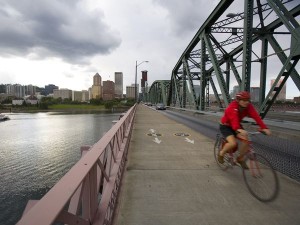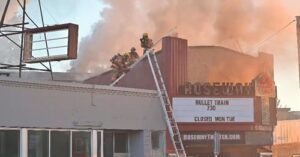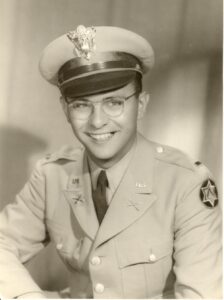I have lived a long life and I intend to keep living it, but I want to take a walk back briefly through the communities I once called home and explain why my current hometown is so different.
I was born in Portland, Ore., a city that seemed stuck on a certain population of about 375,000 people through the 1950s and 1960s. The Army called me into active duty in 1968 and I returned to Portland, where the population stayed more or less the same through the 1970s and much of the 1980s. My career then summoned my family and me to Beaumont, Texas, a nice city to be sure, but one trapped in the era of “white flight” of residents to the suburbs. The population of Beaumont declined during our nearly 11 years on the Gulf Coast, falling from about 120,000 residents to around 115,000. Opportunity knocked again in 1995 and my wife and I moved to Amarillo, way up yonder in the Panhandle. The city enjoyed slow, but steady growth during our 23 years there. The city grew from about 180,000 residents to just less than 200,000. In 2019, I was retired from daily journalism and Kathy Anne and I moved to Princeton, Texas, a Dallas suburb about 25 miles northeast of Dallas. Then it came, a population explosion the likes of which I never had experienced. We bought our home at the right time, securing a loan for a ridiculously low interest rate. New residents came pouring into our city. The population exploded from 6,800 residents in 2010 to 17,027 in 2020. Today the city estimates the city is home to 40,000 residents. Forty thousand people now call Princeton home! That number is continuing to explode. The city council has invoked a ban on residential construction permits, but it must honor the permits already granted and the housing construction already underway. I am filled with anxious anticipation as Princeton grapples with this growth. Texas highway planners have big projects set for U.S. 380. City public works crews have to install new water and sewer lines. Police and fire departments need to hire more personnel. The school system is building campuses as quickly as it can but they are being overwhelmed by new students pouring into the district. The city desperately needs more commercial development to serve the thousands of new residents who are moving here. Those of us who already are here must watch as the city grapples with solutions to the “problem” officials face. How to cope with the tide of people who realize what many of us knew all along, that Princeton is a nice place to call home. City Hall’s challenge is to maintain Princeton’s desirability.Tag Archives: Portland OR
Better friends … than ever!
Someone posted a question on social media that drew an out-loud laugh from this old man.
“How many of you are friends with someone you knew in high school?” this individual asked.
So help me I chuckled out loud … loud enough for my puppies to hear me and come running to see for themselves.
Here’s the back story …
I graduuated from Parkrose High School in Portland, Ore., in June 1967. They called it the Summer of Love. Whatever. The truth of my high school years was that I didn’t have many friends. I was painfully shy around girls and so I didn’t date. That’s right … I dated no one from my high school. I had a few close friends, maybe two or three. I met one of them the day I reported for junior high school in March 1962 after my parents moved us to the suburbs.
Dennis and I have been close friends ever since.
I change came over me in the 58 years since I graduated from high school. I snapped out of my shyness, thanks in large part to the girl I met in college in January 1971 and whom I would marry and spend 51 glorious years in her embrace.
We traipsed through life and along the way I came across men and women I knew back in high school. I was unafraid to chat them up, whereas before I wouldn’t have dared try to engage them in conversation.
Over the years as social media has advanced and taken over many millons of Americans’ lives, I now find myself with quite a few more friends from high school than I had in the olden days. Some of them are men with whom I share a common bond called “the Vietnam War.” Others are guys who just pop up from time to time on Facebook friend request feeds, enabling us to connect. Others still are women who these days are all grown up and understand why some of us boys were too shy to reach out before.
I cannot count a lot of high school-age friends, but my network of acquaintances surely has grown … thanks to social media.
Hey, it’s not all bad. You know?
Portland, still alive and vital
PORTLAND — I am happy and proud to report that my hometown’s demise as an urban center full of joy and laughter has been greatly exaggerated.
I took a spin through the city’s downtown district and noticed a couple of things I didn’t quite expect to see. One was that the widespread damage caused by the “Black Lives Matter” riots of 2020 doesn’t exist. The other is a noticeable disappearance of homeless havens scattered throughout the city of my birth.
The MAGA goon squad wanted to infuse the nation with the idea that this urban paradise had gone straight to hell with riots in reaction to George Floyd’s murder at the hands of a Minneapolis police officer. I didn’t see any evidence today of Hell on Earth making an appearance in one of the country’s most beautiful cities.
Also missing were the clusters of tents occupied by homeless families along Interstate 5 that I saw the previous time I visited Portland, which was not long after the Minneapolis cop choked the life out of George Floyd. I don’t know what specific action Portland took, but whatever it was it seems to have had a positive impact on the city.
Portland appears to have survived the worst of the reactions that ignited in cities across the land. I drove quickly past Powell’s used book store — the renowned readers paradise along West Burnside; the place was buzzing. I saw plenty of activity along Broadway. Downtown Portland, in a word, was a happening place.
This makes me feel good about the city where I came of age.
Mission: to see downtown for myself
PORTLAND, Ore. — I came here to visit a family member, to see some dear friends … and to take a gander for myself at the condition of the resurgent downtown district in the city of birth.
I keep hearing from visitors and even from those who’ve never been to Portland that downtown has become ravaged by the homeless crisis and by the riots that ensued after George Floyd was murdered by Minneapolis police.
Businesses are fleeing downtown Portland, the chatter has revealed. The once vibrant downtown entertainment district is a mere imitation of what it used to embody, many have told me. Indeed, Portland has become a model for urban renewal and revitalization.
I tend to withhold judgment on these matters until I can lay own set of eyes on them. I am staying with my sis in La Center, about 12 miles north of Vancouver, Wash. I am hoping to venture downtown to take a peek at what is happening there. I’ll report back on what I see … if I am able to see it.
My hope is that the reports are overcooked. My fear is that they might be selling it all far too short.
I’ll get back to you.
Mayor’s legacy lives on
PORTLAND, Ore. — At the risk of being hooted out of the blogging world, I feel the need to extol the legacy that a once-promising politician left behind in the city he led as its mayor.
Neil Goldschmidt took office at City Hall as a young whipper-snapper in 1972. I think he was 32 years of age, a young man elected to lead a city that at the time had about 375,000 residents.
He then proceeded to map out an agenda aimed at creating a vibrant downtown district and enhancing the city’s mass transit system.
Goldschmidt vetoed what was called the Mount Hood Freeway project, which was planned as a highway system from southeast Portland east to Mount Hood, about 50 miles away. The mayor said he didn’t want an endless series of strip malls developed along that corridor.
Instead, he persuaded the city council to focus its interests on downtown and on mass transit. He succeeded.
What has occurred in the 50 years since then is the city’s downtown district became a showpiece. The city’s bus and light-rail systems are the envy of other cities.
Oh, but wait. Goldschmidt then became transportation secretary in the Carter administration before being elected governor of Oregon. Then it hit the fan, as he was exposed as a pedophile after a newspaper investigation revealed he seduced a teenager while he was serving as mayor; reporting revealed he had sex multiple times with an underage girl.
His public service career ended on the spot. He resigned from every board on which he served. The State Capitol staff took down his governor’s portrait from the gallery of former governors and stashed it out of sight.
Goldschmidt went from municipal pioneer to pariah overnight.
He’s gone from public view, but the legacy he built remains. His reputation never will be restored. I don’t necessarily want, though, for the city treasure he discovered to be buried.
Watch out, big-city mayors
Some mayors of Texas’s largest cities appear headed for easy re-election in May, according to an article in the Texas Tribune.
The Tribune notes that Dallas Mayor Eric Johnson is unopposed, Fort Worth Mayor Mattie Parker has token opposition, as does San Antonio Mayor Ron Nirenberg.
It’s a walk in the park for them, the Tribune notes. Hey, this makes me say: Not so fast.
Dallas, Fort Worth and San Antonio’s incumbent mayors face easy May races | The Texas Tribune
I recall a time in my hometown of Portland, Ore. — another “big city” of some note — when the incumbent mayor, Francis Ivancie, was thought to be headed toward easy re-election in 1984.
Then along came a saloon owner named Bud Clark, who surprised everyone with an upset victory. How did he do it? Well, Clark had appeared on a poster promoting the arts community in which he posed with his back to the camera, he opened his trench coat in front of some statue and the caption read: “Expose yourself to art.”
A word of warning to Nevadans – High Plains Blogger (wordpress.com)
Ivancie thought he’d make a big deal out of the “immorality” of such a poster. He turned a non-issue into a big issue … except that it backfired on the mayor. Portland voters became smitten with Clark’s approach to life in general and in municipal governance.
So, they elected him.
This is my way of saying that the big-city mayors in Texas need to pick their battles carefully if they intend to stay in office.
A surprising bit of candor
It just flew out of my mouth the moment I heard the question: Do I miss Portland? My answer, which came without the slightest hesitation: No. I do not.
I was wearing an Oregon Ducks ballcap when we walked into a Barnes & Noble bookstore in Frisco, Texas, the other day. The lady at the counter saw the hat, recognized me as a Ducks fan and made some comment about the hat I was wearing. I asked her where she is from; she told me Lynwood, a suburb of Seattle.
We chatted for a moment and I told her I grew up in Portland. I thought for a moment about mentioning how the Ducks have owned the University of Washington Huskies over the past 15 years of the schools’ football rivalry, then thought better of it. Then came the question about missing it and my strangely quick and candid answer.
Portland doesn’t resemble the city I knew as a boy and then as a much younger man. It’s gotten, to my way of thinking, a bit full of itself. Traffic is terrible. Streets are narrow. Real estate prices have rocketed into outer space. The lady mentioned how “quirky” Portland always has been, but that it’s gotten a bit strange in recent years. Quirky, I can handle. That doesn’t bother me. It just no longer feels like “home.”
All of that plus the fact that I am now well into my 70s. I no longer work full time.
Do I miss my family members who still live there or nearby? Yes. Do I miss our many friends? Yes … of course to both questions.
But we moved away in the spring of 1984 to pursue a journalism career that took me many places over the course of many years in Texas. We built a good life, first in Beaumont, then in Amarillo, and now in Princeton, where we settled into what we call our “forever home.”
I long have been amazed at how adaptable I proved to myself I could be when we decided to take a leap of faith some 38 years ago. That was then. I sense I am a good bit less adaptable these days.
A bit of history burns away
I just got some stunning news that I want to share with anyone — and I am going to presume that means “everyone” — who has a special place where they came of age.
The Roseway Theater in Portland, Ore., caught fire and burned … almost to the point of destruction.
This place means a lot to little ol’ me. I used to attend Saturday matinees there, mostly with my sister.
Historic theater partially collapses in 3-alarm fire in NE Portland (kptv.com)
It was a meeting place for many of us who grew up in that neighborhood. You know what I mean, right? Friends would gather to watch a movie, carry on and laugh — a lot.
It was the place where I enjoyed my first kiss. Yes, I remember her name, even though it was, shall we say, a very long time ago.
The Roseway Theater also was the place where I had my brush with infamy.
The movie ended one evening. I went outside with a couple of friends and lit up a cigarette. A police officer approached me and asked me my age. I told him 16. He said, “You’re under arrest.” He then escorted me to a paddy wagon — yes, an actual paddy wagon! — and hauled me downtown. The cops called my parents, told ’em they had me in custody for smoking; Mom fetched me.
My evening didn’t end well, if you get my drift.
Still, the Roseway Theater is part of my history and I am saddened to believe it might no longer exist.
The building was erected in 1925. It has withstood a lot, I presume, over the many decades of its existence. To me it is a symbol of my youth, just as I am absolutely certain we all have such symbols of our past.
Keep those places near to your heart. They can vanish in a flash.
Preparing for a sad, but also joyful, duty
I am preparing at this moment to take a four-hour ride from Dallas-Fort Worth airport to Portland, Ore., where I will participate in what can be best described as a cycle of life ritual.
I will bid farewell to my beloved uncle, Jim Phillips. I will be there along with his wife, his children, many of his grandchildren, one of my sisters and virtually all of my cousins on my mother’s side of my boisterous family.
It will sadden me to say goodbye. It also will enable us to rejoice in the full and fruitful life he had over the span of his 93 years on this good Earth. We will gather to remember the richness that Uncle Jim brought to us. I trust we all will in our own way pledge to cling to those memories as we move on through the rest of our lives. Those thoughts will not sadden me. They will make me smile.
These events are part of what all families must endure. Indeed, as I am now well into that stage of my own life, having just turned 70 a little while back, my sisters, along with my wife and sons, realize as I do that the clock is ticking for all of us. The number of our family elders with whom we grew up is diminishing far too rapidly.
However, it is the inevitable march of time over which no one has any control.
It’s been said many times by many people perhaps over many adult beverages that “Not a single one of us gets outta here alive.”
So it goes … and so it will be.
Cruz gets blowback from criticizing O’Rourke’s potty mouth
U.S. Sen. Ted Cruz’s re-election campaign is trying to paint challenger Beto O’Rourke as a potty-mouthed punk who drops f-bombs at random.
Social media response has been, well, a bit different from what the Cruz campaign expected. The revelation seems to be making the Democratic challenger seem more cool.
This mini-tempest makes me laugh and it reminds me of something that happened back in my hometown of Portland, Ore., during a race for the mayor’s office.
Incumbent Mayor Frank Ivancie’s 1984 re-election campaign dug up a 1978 picture of a challenger, Bud Clark — owner of the legendary downtown Park Blocks watering hole the Goose Hollow Inn — “exposing himself” before a statue. The picture showed Clark with his back to the camera pulling open a trench coat with the caption “Expose Yourself to Art.”
Ivancie, a man with no discernible sense of humor, thought the picture would doom Clark’s insurgent candidacy. It did precisely the opposite. It called attention to the challenger and — no pun intended — exposed Ivancie to be a stuffed-shirt prude.
Clark won the election, defeating Ivancie.
So, with that I want to hail the attempt by Sen. Cruz’s team to make Beto O’Rourke out to be a young man with a foul mouth. It well might produce the same result that occurred in Portland so many years ago.



